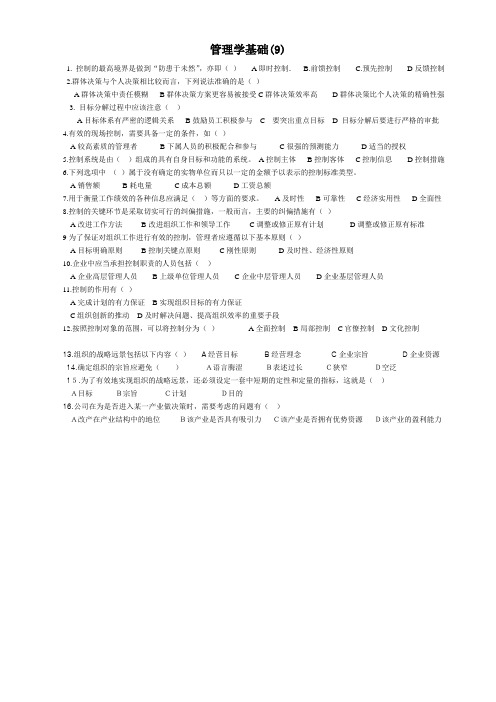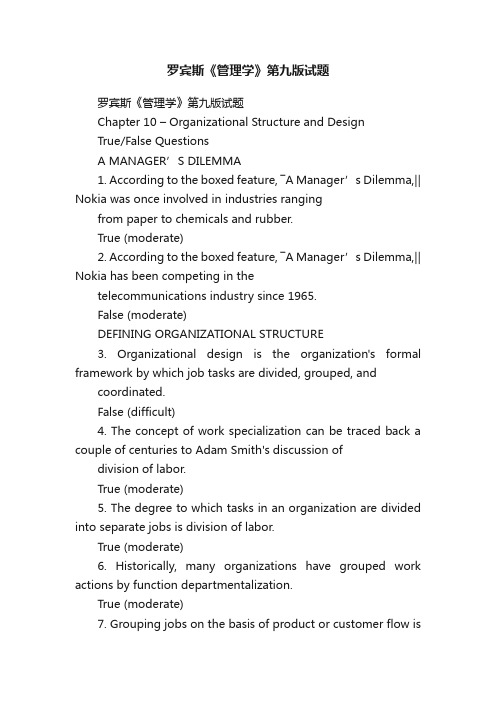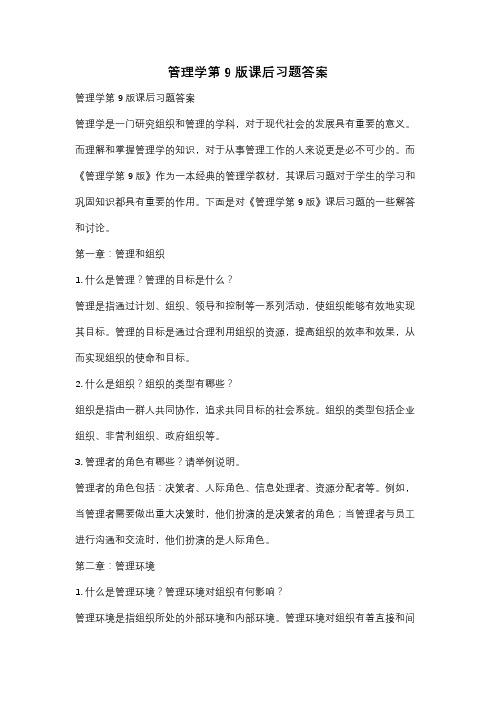9市场管理学
- 格式:pptx
- 大小:719.35 KB
- 文档页数:5


第九章领导的一般理论习题(一)判断题1.领导是为了维持秩序,在一定程度上实现预期的计划,使事物能够高效地运转,而管理则能带来变革,通常是剧烈的、积极的变革()。
2.领导者的权力来源于职位权力、参照权力和专家权力。
( )3.领导者特质理论认为成功的领导基于领导者个人特质,并且这些特质只存在于少数英雄人物身上。
( )4.勒温等人的研究结果显示,民主型领导方式一般要比独裁型领导方式来得更有效。
( )5.如果高层管理团队是高度分散的,只是单个管理者的集合,而非一个团队,那么其整体特征对组织绩效的影响就不大。
( )6.亨利·明茨伯格提出的领导角色理论中,他认为企业家的角色是10种角色中最显著一种角色,也是管理者权力最明显的表现。
()7.为了测量领导者属于哪一种风格,费德勒设计了最难共事者LPC问卷,并认为在LPC问卷上打分较高(64分及以上)的人,是属于关系取向型领导风格。
( )8.路径—目标理论以激励理论中的期望理论为基础。
( )(二)填空题1.勒温总结了领导方式基本上有三种类型,,.2.布莱克和莫顿在提出管理方格理论时,列举了五种典型的领导方式:、、、、。
3.按照权变理论,领导者的风格分为两类:和__ .4.费德勒的权变模型指出组织的效率取决于两个变量的相互作用:和。
5.费德勒从三个维度对情境是否有利进行分析:,,和。
6.密歇根州立大学关于领导行为的研究,其目的是区分和的管理者。
7.费德勒模型中的任务结构指。
8.管理方格图中的纵轴表示领导者对的关心程度,横轴表示领导者对的关心程度。
(三)选择题1.提出权变理论的是。
A.吉沙利B.费德勒C.布莱克D.施米特2.管理方格图中,型对应的是领导方式。
A.任务型B.乡村俱乐部型C.中间型D.团队型管理3.王先生是果公司的一名年轻技术人员,一年前被调到公司企划部任经理,考虑到自己的资历、经验等,他采取了较为宽松的管理方式,试分析下列哪一种情况下,王先生的领导风格最有助于产生较好的管理效果。

管理学基础(9)1. 控制的最高境界是做到“防患于未然”,亦即()A即时控制. B.前馈控制 C.预先控制D反馈控制2.群体决策与个人决策相比较而言,下列说法准确的是()A群体决策中责任模糊B群体决策方案更容易被接受C群体决策效率高D群体决策比个人决策的精确性强3. 目标分解过程中应该注意()A目标体系有严密的逻辑关系B鼓励员工积极参与 C 要突出重点目标 D 目标分解后要进行严格的审批4.有效的现场控制,需要具备一定的条件,如()A较高素质的管理者B下属人员的积极配合和参与C很强的预测能力D适当的授权5.控制系统是由()组成的具有自身目标和功能的系统。
A控制主体B控制客体C控制信息D控制措施6.下列选项中()属于没有确定的实物单位而只以一定的金额予以表示的控制标准类型。
A销售额B耗电量C成本总额D工资总额7.用于衡量工作绩效的各种信息应满足()等方面的要求。
A及时性B可靠性C经济实用性D全面性8.控制的关键环节是采取切实可行的纠偏措施,一般而言,主要的纠偏措施有()A改进工作方法B改进组织工作和领导工作C调整或修正原有计划D调整或修正原有标准9为了保证对组织工作进行有效的控制,管理者应遵循以下基本原则()A目标明确原则B控制关键点原则C刚性原则D及时性、经济性原则10.企业中应当承担控制职责的人员包括()A企业高层管理人员B上级单位管理人员C企业中层管理人员D企业基层管理人员11.控制的作用有()A完成计划的有力保证B实现组织目标的有力保证C组织创新的推动D及时解决问题、提高组织效率的重要手段12.按照控制对象的范围,可以将控制分为()A全面控制B局部控制C官僚控制D文化控制13.组织的战略远景包括以下内容()A经营目标B经营理念C企业宗旨D企业资源14.确定组织的宗旨应避免()A语言脢涩B表述过长C狭窄D空泛15.为了有效地实现组织的战略远景,还必须设定一套中短期的定性和定量的指标,这就是()A目标B宗旨C计划D目的16.公司在为是否进入某一产业做决策时,需要考虑的问题有()A改产在产业结构中的地位B该产业是否具有吸引力C该产业是否拥有优势资源D该产业的盈利能力。

罗宾斯《管理学》第九版试题罗宾斯《管理学》第九版试题Chapter 10 – Organizational Structure and DesignTrue/False QuestionsA MANAGER’S DILEMMA1. According to the boxed feature, ―A Manager’s Dilemma,‖ Nokia was once involved in industries rangingfrom paper to chemicals and rubber.True (moderate)2. According to the boxed feature, ―A Manager’s Dilemma,‖ Nokia has been competing in thetelecommunications industry since 1965.False (moderate)DEFINING ORGANIZATIONAL STRUCTURE3. Organizational design is the organization's formal framework by which job tasks are divided, grouped, and coordinated.False (difficult)4. The concept of work specialization can be traced back a couple of centuries to Adam Smith's discussion ofdivision of labor.True (moderate)5. The degree to which tasks in an organization are divided into separate jobs is division of labor.True (moderate)6. Historically, many organizations have grouped work actions by function departmentalization.True (moderate)7. Grouping jobs on the basis of product or customer flow istermed customer departmentalization.False (moderate)8. Geographic departmentalization has greatly increased in importance as a result of today’s competitivebusiness environmentFalse (moderate)9. A group of individuals who are experts in various specialties and who work together is a cross-functional team.True (moderate)10. Authority is the individual's capacity to influence decisions.False (difficult)11. Authority is synonymous with responsibility.False (easy)12. Responsibility is the rights inherent in a managerial position.False (easy)13. A manager's span of control refers to the number of subordinates who can be effectively and efficientlysupervised.True (moderate)14. The classical view of unity of command suggests that subordinates should have only one superior to whom they report.True (easy)15. The trend in recent years has been toward smaller spans of control.False (easy)16. When decisions tend to be made at lower levels in anorganization, the organization is said to bedecentralized.True (moderate)17. Decentralization describes the degree to which decision making is concentrated at a single point in theorganization.False (moderate)18. In the last 35 years, there has been a trend of organizations moving toward increased decentralization.True (easy)19. Appropriate organizational structure depends on four variables: the organization's strategy, size, technology, and degree of environmental uncertainty.True (difficult)20. Standardization refers to the degree to which jobs within the organization are standardized and the extent towhich employee behavior is guided by rules and procedures.False (moderate)ORGANIZATIONAL DESIGN DECISIONS21. An organic organization tends to be characterized by high specialization, extensive departmentalization,narrow spans of control, high formalization, a limited information network, and little participation indecision-making by low-level employees.False (moderate)22. An organic organization would likely be very flexible.True (moderate)23. Innovators need the efficiency, stability, and tight controls of the mechanistic structure.False (easy)24. The relationship between organizational size and structure tends to be linear.False (difficult)25. Joan Woodward attempted to view organizational structure from a technological perspective.True (moderate)26. Woodward demonstrated that organizational structures adapted to their technology.True (moderate)27. Woodward's findings support that there is "one best way" to organize a manufacturing firm.False (moderate)28. The strength of the functional structure is that it focuses on results.False (moderate) it is the strength of divisional structure.\\\\\\\29. According to the text, a functional structure creates strategic business units.False (moderate)COMMON ORGANIZATIONAL DESIGNS30. Project structures tend to be rigid and inflexible organizational designs.False (easy)Multiple ChoiceA MANAGER’S DILEMMA31. Accordi ng to t he company profile in ―A Manager’s Dilemma,‖ the organizational structure of Nokia is best described as ______________.a. mechanisticb. organic (moderate)c. centralizedd. formalized32. The factor contributing the most to Nokia’s success in the mobile phone industry according to the company profile in ―A Manager’s Dilemma‖ is ______________.a. new product development (moderate)b. government subsidiesc. national trade barriersd. weak competition33. ______________ is the process of creating an organization's structure.a. Human resource managementb. Leadingc. Organizing (moderate)d. Planninge. DepartmentalizationDEFINING ORGANIZATIONAL STRUCTURE34. According to the text, a(n) ______________ is the formal framework by which job tasks are divided,grouped, and coordinated.a. mission statementb. environmental scanc. internal resource analysisd. organizational structure (moderate)35. Which of the following is not one of the six key elements in organizational design?a. work specializationb. departmentalizationc. chain of commandd. bureaucratic design (difficult)e. span of control36. Work specialization is also known as ______________.a. departmentalization.b. centralization.c. span of control.d. formalization.e. division of labor. (easy)37. The term ______________ is used to describe the degree to which tasks in an organization are divided intoseparate jobs.a. work ethicsb. managerial capitalismc. social responsibilityd. work specialization (moderate)38. When did the idea of enlarging, rather than narrowing, job scope begin?a. 1950sb. 1960s (moderate)c. 1970sd. 1980se. 1990s39. Which of the following is not an example of the classical viewof division of labor?a. assembly-line productionb. Burger Kingc. Taco Belld. TQM (moderate)e. Kentucky Fried Chicken40. ______________ is the basis on which jobs are grouped inorderto accomplish organizational goals.a. Departmentalization (moderate)b. Centralizationc. Formalizationd. Coordinatione. Efficiency41. A local manufacturing organization has groups of employees whoare responsible for sales, marketing,accounting, human resources, etc. These are examples of what concept?a. authorityb. chain of commandc. empowermentd. departmentalization (moderate)e. social grouping42. Grouping sporting equipment in one area, men's clothing in another area, and cosmetics in a third area, is anexample of what kind departmentalization?a. customerb. product (easy)c. geographicd. processe. outcome43. Sales responsibilities divided into the southwest, midwest, southern, northern, and western regions would bean example of ______________ departmentalization.a. productb. geographic (easy)c. processd. outcomee. customer44. Grouping activities on the basis of customer flow is______________.a. functional departmentalization.b. product departmentalization.c. geographical departmentalization.d. process departmentalization. (moderate)e. technological departmentalization.45. What type of departmentalization expects that each department will specialize in one specific phase of the process or product production?a. productb. geographicc. process (easy)d. outcomee. customer46. What kind of departmentalization would be in place in a government organization where different publicservice responsibilities are divided into activities for employers, children, and the disabled?a. productb. geographicc. processd. outcomee. customer (moderate)47. Which of the following is not a form of departmentalization suggested by your text?a. functional departmentalizationb. product departmentalizationc. geographical departmentalizationd. process departmentalizatione. technological departmentalization (difficult)48. Today's competitive business environment has greatly increasedthe importance of what type ofdepartmentalization?a. geographicb. customer (difficult)c. productd. processe. outcome49. According to the text, managers are using ______________, which are groups of individuals who areexperts in various specialties and who work together.a. specialized teamsb. cross-demanded teamsc. cross-functional teams (moderate)d. simple structured teams50. Which of the following is a contemporary addition to thehistorical view of departmentalization?a. increased rigidityb. cross-functional teams (moderate)c. enhanced centralizationd. elimination of product departmentalizatione. addition of sales departmentalization51. Bringing together the company's legal counsel, research engineer, and marketing specialist for a project isan example of a(n) ______________.a. empowered team.b. process departmentalization.c. product departmentalization.d. cross-functional team. (moderate)e. continuous improvement team.52. The ______________ is the continuous line of authority that extends from upper organizational levels to thelowest levels and clarifies who reports to whom.a. chain of demandb. chain of command (easy)c. demand hierarchyd. continuous design structure53. To whom a worker reports concerns which aspect of organizational structure?a. chain of command (moderate)b. departmentalizationc. pay structured. line of commande. authority framework54. ______________ entitles a manager to direct the work of a subordinate.a. Responsibilityb. Legitimate powerc. Rankd. Operating responsibilitye. Authority (moderate)55. ______________ is the obligation to perform assigned activities.a. Authorityb. Responsibility (easy)c. Chain of commandd. Unity of commande. Formalization56. The ______________ principle (one of Fayol’s 14 principles of management) helps preserve the concept ofa continuous line of authority.a. unity of demandb. unity of command (moderate)c. demand structured. continuous demand57. Span of control refers to which of the following concepts?a. how much power a manager has in the organizationb. the geographic dispersion of a manager's subunits ofresponsibilityc. how many subordinates a manager can effectively and efficiently supervise (moderate)d. the number of subordinates affected by a single managerial ordere. the amount of time it takes to pass information down through a manager's line of command58. Other things being equal, the wider or larger the span of control, the more ______________ theorganizational design.a. bureaucraticb. democraticc. effectived. efficient (difficult)e. classical59. Wider spans of control may be viewed as more efficient, but eventually, wider spans tend to have whateffect on organizations?a. reduced effectiveness (difficult)b. increased turnoverc. loss of managerial powerd. customer dissatisfactione. rigid chains of command60. An organization that spends money on maintaining a well-trained work force can expect which of thefollowing span-of-control outcomes?a. increased contempt for managementb. increased voluntary turnoverc. centralized authorityd. less direct supervision (moderate)e. increased need for managerial-level employees61. A high-tech manager who supervises the development of a new computer chip needs ______________compared to a manager who supervises the mailing of unemployment insurance checks at the localgovernment office.a. about the same span of controlb. a narrower span of control (difficult)c. a wider span of controld. a more informal span of controle. elimination of the span of control62. In general, span of control is ______________ for managers.a. increasing (easy)b. decreasingc. staying the samed. significantly decreasinge. no longer important63. ______________ describes the degree to which decision making is concentrated at a single point in theorganization.a. Decentralizationb. Centralization (moderate)c. Transnationalismd. Cross sectional analysis64. If lower-level employees provide input or are actually given the discretion to make decisions, theorganization is ______________.a. formalized.b. centralized.c. decentralized. (easy)d. mechanistic.e. organic.65. Recently, there has been a distinct trend toward ______________.a. smaller spans of control.b. decentralized decision-making. (moderate)c. decreased flexibility.d. emphasis on chain of command.e. mechanistic organizations.66. Which of the following factors WOULD NOT influence an organization to have a higher degree ofcentralization?a. Environment is stable.b. Company is geographically dispersed. (difficult)c. Company is large.d. Decisions are significant.e. Organization is facing a crisis.67. ______________ refers to the degree to which jobs within the organization are standardized and the extentto which employee behavior is guided by rules and procedures.a. Standardizationb. Centralizationc. Chain of commandd. Strategye. Formalization (moderate)68. All of the following factors indicate that a decentralized organization would be most effective EXCEPTwhen ______________.a. the environment is complex.b. decisions are relatively minor.c. the organization is facing a crisis. (difficult)d. the company is geographically dispersed.e. effective implementation of strategies depends on managers having involvement and flexibilityto make decisions.69. Which of the following factors describes an environment in whicha high degree of decentralization isdesired?a. Environment is complex, uncertain. (moderate)b. Lower-level managers do not want to have a say in decisions.c. Decisions are significant.d. Company is large.e. Organization is facing a crisis or the risk of company failure.70. The ______________ organizational structure is characterized by high specialization, extensivedepartmentalization, narrow spans of control and high formalization.a. mechanistic (easy)b. organicc. contingencyd. adhocracye. functional71. Which of the following is NOT a characteristic of a mechanistic organization?a. high specializationb. wide spans of control (moderate)c. high formalizationd. limited information networke. extensive departmentalization72. What type of organizational form follows classical principles such as unity of command?a. organicb. linearc. decentralizedd. mechanistic (moderate)e. adhocracyORGANIZATIONAL DESIGN DECISIONS73. Which of the following would likely be found in mechanistic organizations?a. wide span of controlb. empowered employeesc. decentralized responsibilityd. few rules and/or regulationse. standardized job specialties (difficult)74. All of the following are characteristics of an organic organization EXCEPT:a. narrow spans of control. (moderate)b. cross-hierarchical teams.c. free flow of information.d. low formalization.e. cross-functional teams.75. In the early years of Apple Computers, its desire for highly proficient and creative employees who operatedwith few work rules was an example of what type of organization?a. bureaucraticb. mechanisticc. volatiled. nouvellee. organic (difficult)。

管理学第9版课后习题答案管理学第9版课后习题答案管理学是一门研究组织和管理的学科,对于现代社会的发展具有重要的意义。
而理解和掌握管理学的知识,对于从事管理工作的人来说更是必不可少的。
而《管理学第9版》作为一本经典的管理学教材,其课后习题对于学生的学习和巩固知识都具有重要的作用。
下面是对《管理学第9版》课后习题的一些解答和讨论。
第一章:管理和组织1. 什么是管理?管理的目标是什么?管理是指通过计划、组织、领导和控制等一系列活动,使组织能够有效地实现其目标。
管理的目标是通过合理利用组织的资源,提高组织的效率和效果,从而实现组织的使命和目标。
2. 什么是组织?组织的类型有哪些?组织是指由一群人共同协作,追求共同目标的社会系统。
组织的类型包括企业组织、非营利组织、政府组织等。
3. 管理者的角色有哪些?请举例说明。
管理者的角色包括:决策者、人际角色、信息处理者、资源分配者等。
例如,当管理者需要做出重大决策时,他们扮演的是决策者的角色;当管理者与员工进行沟通和交流时,他们扮演的是人际角色。
第二章:管理环境1. 什么是管理环境?管理环境对组织有何影响?管理环境是指组织所处的外部环境和内部环境。
管理环境对组织有着直接和间接的影响,它可以影响组织的发展和运营。
外部环境包括经济环境、政治环境、社会文化环境等,而内部环境包括组织的结构、文化、人力资源等。
2. 请列举几个影响管理环境的因素,并简要说明其影响。
影响管理环境的因素有很多,如经济因素、技术因素、法律因素等。
经济因素会直接影响组织的运营和发展,技术因素则会影响到组织的生产力和竞争力,法律因素则会对组织的运营和管理提出一系列要求和限制。
第三章:管理理论1. 请简要介绍几个著名的管理理论。
凯奇管理理论认为,管理者应该关注员工的需求和动机,通过激励和奖励来提高员工的工作表现。
赫茨伯格和麦格雷戈的理论则强调了员工的动机和领导行为的关系,他们提出了“X理论”和“Y理论”,分别代表了不同的领导风格和对员工动机的看法。

管理学十大经典理论管理学是一门研究管理和组织的学科,它主要关注企业、组织和机构的管理和运营。
管理学的范围广泛,包括战略管理、人力资源管理、市场营销、财务管理等等。
在管理学中,存在着很多经典理论,这些经典理论被广泛应用于企业和组织的管理和运营中。
本文将介绍管理学十大经典理论。
1、泰勒管理思想泰勒管理思想是管理学的奠基之一,也是现代管理的基石。
泰勒提出了科学管理和劳动分工的概念,强调科学方法的应用和人力资源最大化的利用,对现代企业的生产和管理做出了巨大的贡献。
2、韦伯理论韦伯理论是管理学中的一个重要流派,韦伯强调权威性、规则性和合法性,他认为企业组织架构应该建立在这三个基础上。
他的理论提供了一个基于规则、层级和权威的企业组织框架,对企业管理的规范化和形式化起到了积极的作用。
3、马斯洛需求层次理论马斯洛提出的需求层次理论是管理学中的一项重要成果。
他认为人的需求分为生理需求、安全需求、社交需求、尊重需求和自我实现需求五个层次。
这个理论强调了人的精神需求和心理需求,引导企业管理者更好地关注员工的满足感和发展潜力,提升企业绩效。
4、系统论系统论是管理学中一个重要的方法论,主要是研究企业管理系统和企业组织的运转规律。
系统论认为企业是一个有机系统,包括多个部门、流程和功能,这些部分相互作用和影响,并以一定目标为导向。
系统论强调了集成化、整体性和协同性,有助于企业精细化管理和优化运营。
5、哈茨伯格双因素理论哈茨伯格双因素理论是企业管理中一个常用的理论,他认为员工的工作满意度由两个因素决定。
一是基本工作条件的满足,如工资福利、工作环境等;二是工作内容的挑战性和发展性。
这个理论强调了个人成长和发展的重要性,为企业提供了提升员工工作满意度和忠诚度的思路。
6、弗雷德里克森领导风格理论弗雷德里克森领导风格理论是研究领导与管理的重要理论。
他认为领导风格可以分为任务导向型和关系导向型两种类型,这两种类型可以通过组织目标的具体情况来选择。
199管理类综合能力参考书目 2025年以下是一份管理类综合能力的参考书目,旨在帮助读者在2025年提升他们的管理能力,以适应不断变化的商业环境和对领导者的需求。
这些书籍涵盖了管理理论、领导力发展、团队建设、战略规划、创新思维以及组织文化等方面的内容。
1.《从优秀到卓越》(作者:吉姆·柯林斯)这本畅销书深入研究了大型企业如何从一流转向卓越,通过案例研究探讨了战略决策、领导力发展和组织文化的关键要素。
2.《决策与创新》(作者:彼得·德鲁克)这是一本经典的管理学著作,讲述了有效决策的原则和方法,并强调创新对组织发展的重要性。
3.《团队的五大发展阶段》(作者:布鲁斯·塔克曼)这本书解释了团队发展的不同阶段,并提供了有效管理团队的策略和技巧,对于领导者来说非常有用。
4.《创新者的窘境》(作者:克莱顿·克里斯坦森)这本书关注创新的过程和障碍,探讨了为什么大型企业往往难以适应变化,以及如何在竞争激烈的市场中保持创新。
5.《劝说力》(作者:罗伯特·卡尔迪尼)这本书介绍了影响他人和取得合作的技巧,对于管理者在与他人沟通、推销自己的想法和领导团队时非常有帮助。
6.《从优秀到史诗般伟大》(作者:吉姆·柯林斯)这本书继续深入研究卓越企业的特征,探索了管理者如何通过领导力、创新和组织文化推动企业发展。
7.《团队教练》(作者:约翰·惠特莫尔)这本书提供了培养高效团队的指南,包括培养团队合作、解决冲突和发挥团队成员潜力的方法。
8.《管理的实践》(作者:彼得·德鲁克)这是一本综合性的管理学教材,涵盖了领导力、组织理论、战略管理等方面的内容,并提供了案例研究和实践建议。
9.《腾飞》(作者:吉姆·柯林斯)这本书基于对知名企业的研究,揭示了企业如何在动荡的商业环境中实现持续创新和成功,并提供了实用的管理方法。
10.《有效的执行者》(作者:彼得·德鲁克)这本书强调了执行力对于管理者的重要性,提供了实践性的建议和工具,帮助管理者转化战略为行动并有效地管理变化。
一、多项选择题〔共20 道试题,共40 分。
〕1. 总体来看,古代城市的经济功能较弱,主要以〔〕为主。
A. 军事功能B. 社会功能C. 政治功能D. 文化功能2. 城市管理学的研究方法有〔〕。
A. 系统分析方法B. 理论联系实际的方法C. 综合分析方法D. 定性分析和定量分析相结合的方法3. 〔〕是城市化的后续动力。
A. 农业现代化B. 科技现代化C. 工业化D. 信息化4. 以下关于新公共管理理论说确的是〔〕。
A. 更加注重对部系统的管理B. 强调管理对象的外部化C. 强调以什么方式实施管理会加强管理的便利性D. 强调提高管理的部效率5. 〔〕是市人民代表大会的执行机关,是城市国家行政机关。
A. 市人民政府B. 市人民法院C. 市人民检察院D. 市政协6. 在我国城市中,城市政治权力系统包括〔〕。
A. 市人大B. 中共市委C. 市政协D. 市政府7. 在我国,市人民团体特指〔〕。
A. 市妇联B. 市共青团C. 市红十字协会D. 市工会8. 中共市委对〔〕起着领导作用,处于领导地位。
A. 市人民政府B. 市人民法院C. 市人民检察院D. 市人大9. 〔〕属于初级城市开展战略观。
A. 营销导向B. 需求型C. 供应型D. 资源型10. 城市开展战略通常由〔〕组成。
A. 战略措施B. 战略反应C. 重点战略D. 战略依据和战略愿景11. 城市现代化目标体系,主要包括〔〕。
A. 生活质量指标B. 生态环境指标C. 社会进步指标D. 经济开展指标12. 我国土地储藏的运行模式包括〔〕。
A. 模式B. 模式C. 模式D. 模式13. 近代城市规划始于〔〕。
A. 美国B. 英国C. 法国D. 德国14. 我国现阶段城市规划的根本任务是〔〕。
A. 保护和修复人居环境,尤其是城乡空间环境的生态系统,为城乡经济、社会和文化协调、稳定地持续开展效劳B. 保障和创造城市居民平安、安康、舒适的空间环境C. 保障和创造城市公正的社会环境D. 保障和创造城市公正的人文环境15. 在社会主义市场经济条件下,宏观调控具有〔〕的特征。